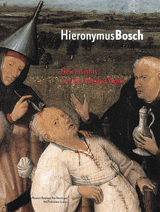
Silva Maroto 2001
“Bosch in Spain: On the Works Recorded in the Royal Inventories” (Pilar Silva Maroto) 2001
[in: Jos Koldeweij, Bernard Vermet and Barbera van Kooij (eds.), Hieronymus Bosch. New Insights Into His Life and Work. Museum Boijmans Van Beuningen-NAi Publishers-Ludion, Rotterdam, 2001, pp. 40-46]
When authors refer to works by Bosch in old Spanish inventories, they often do this in a sloppy way. They don’t mention that a work has been transferred to another location for example, or they don’t give the exact date on which a work was thrown away (because it was too old and torn). Yet these things can provide us with information about the changing esteem in which these works were held in the Spanish royal circles from the seventeenth to the nineteenth century. It can be observed that as time passed by some of Bosch’s paintings became less valued and were transferred to less important locations.
Because of the limited space in this contribution Silva Maroto focuses on the inventories of the Pardo palace (not to be mixed up with the Prado). She offers a survey of the works attributed to Bosch in the inventories of 1564, 1591, 1614, 1623, 1653 and 1700. This leads to the conclusion that Philip II not only bought Bosch paintings from the heirs of Felipe de Guevara, but that very probably he also acquired works that belonged to Mencia de Mendoza (the Spanish wife of Henry III of Nassau).
A copy of the Garden of Delights triptych was located in the Pardo palace in 1614. In the inventory the central panel is described as a depiction of worldly pursuits (in the original Spanish: el trafago del mundo). Silva Maroto is of the opinion (without delivering any firm proof for this) that this copy was made in the Netherlands, before the original (then belonging to William of Orange) was confiscated in 1568. In 1623 the copy was still located in the Pardo, but in October/November of that same year it was transferred to the Alcázar in Madrid.
It is a pity that in this contribution the quotations from old inventories are only presented in English. For the original Spanish, though, the reader can turn to Paul Vandenbroeck’s contribution in the same edition (see Vandenbroeck 2001b). It is remarkable that neither Silva Maroto nor Vandenbroeck question the reliability of Spanish attributions to Bosch around 1600.
[explicit]